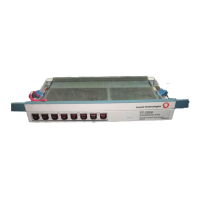Maintenance Description
9-60 Issue 8.0 July 2002
■ At the primary node (node 4), a 1-way drop cross-connection and a 1-way
through cross-connection from the same STS-3 tributary are entered. This
creates a bridge (drop and continue) cross-connection. When entering the
drop and through cross-connections, the termination node (node 5) must
be specified as the source node. When entering the through
cross-connection, the secondary node (node 3) must be specified as the
destination node.
■ At the secondary node (node 3), a 1-way drop cross-connection from the
same STS-3 tributary is entered. When entering the drop cross-connection,
the termination node (node 5) must be specified as the source node.
The following cross-connections are entered in the add direction (Figure 9-18):
■ At the primary node (node 4), a 1-way-DRI cross-connection is entered. A
1-way-DRI cross-connection consists of a 1-way add cross-connection and
a 1-way through cross-connection. When entering the 1-way-DRI
cross-connection, the termination node (node 5) must be specified as the
destination node, and node 3 must be specified as the secondary node.
Initially, the add cross-connection is in the active state and the through
cross-connection is in the standby state.
■ At the secondary node (node 3), a 1-way add cross-connection to the same
STS-3 tributary is entered. When entering the 1-way add cross-connection,
the termination node (node 5) must be specified as the destination node.
■ At the termination node (node 5), a 1-way drop cross-connection from the
same STS-3 tributary is entered. When entering the drop cross-connection,
the secondary node (node 3) must be specified as the source node.
The add and drop directions are completely independent. During normal
transmission, traffic is routed from the termination node (node 5) through the
primary node (node 4) and secondary node (node 3) to the other ring. Traffic from
the other ring is routed through the primary node (node 4) to the termination node
(node 5).
Figure 9-19 shows a dual ring interworking application with a node failure in the
other ring causing an unprotected incoming low-speed loss-of-signal condition at
the primary node (node 4) in the FT-2000 line-switched ring.

